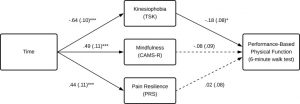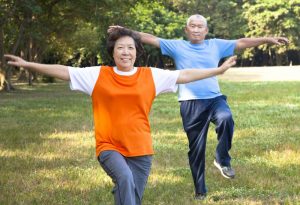Improve Psychological Well-Being in Cancer Survivors with Online Mindfulness-Based Cognitive Therapy (MBCT)
By John M. de Castro, Ph.D.
“both MBCT and eMBCT interventions reduced fear of cancer recurrence and rumination, and increased mental health–related quality of life, mindfulness skills, and positive mental health.” – Félix Compen
Receiving a diagnosis of cancer has a huge impact on most people. Feelings of depression, anxiety, and fear are very common and are normal responses to this life-changing and potentially life-ending experience. These feeling can result from changes in body image, changes to family and work roles, feelings of grief at these losses, and physical symptoms such as pain, nausea, or fatigue. People might also fear death, suffering, pain, or all the unknown things that lie ahead. So, coping with the emotions and stress of a cancer diagnosis is a challenge and there are no simple treatments for these psychological sequelae of cancer diagnosis.
Mindfulness training has been shown to help with cancer recovery and help to alleviate many of the residual physical and psychological symptoms, including fatigue, stress, sleep disturbance, fear, and anxiety and depression. Mindfulness-Based Cognitive Therapy (MBCT) is a well-established therapy that involves mindfulness training and cognitive therapy to change maladaptive thought processes. MBCT has been found to be effective in reducing the residual psychological issues that are common in cancer survivors.
But the vast majority of the mindfulness training techniques require a trained therapist. This results in costs that many parents can’t afford. In addition, the participants must be available to attend multiple sessions at particular scheduled times that may or may not be compatible with parents’ busy schedules and at locations that may not be convenient. As an alternative, mindfulness trainings over the internet have been developed. These have tremendous advantages in making training schedules much more flexible, and eliminating the need to go repeatedly to specific locations. So, it makes sense to explore the effectiveness of internet-based Mindfulness-Based Cognitive Therapy (iMBCT) in treating the psychological symptoms of cancer survivors.
In today’s Research News article “Internet-delivered Mindfulness-Based Cognitive Therapy for anxiety and depression in cancer survivors: Predictors of treatment response.” (See summary below or view the full text of the study at: https://www.ncbi.nlm.nih.gov/pmc/articles/PMC7843453/ ) Nissen and colleagues recruited adult breast and prostrate cancer survivors and randomly assigned them to a wait-list control condition or to receive internet-based Mindfulness-Based Cognitive Therapy (iMBCT); consisting of 8 1-week modules. They were measured before and after training and 6 months later for mindfulness, self-compassion, anxiety, depression, and therapy related working reliance.
They found that at baseline the higher the levels of self-compassion and the mindfulness facets of describing, non-judging, and acting with awareness, the lower the levels of anxiety and depression. Mindfulness-Based Cognitive Therapy (iMBCT) resulted in significant decreases in anxiety and depression. The amount of decrease in anxiety was related to the baseline depression level with the most depressed participants having the greatest reductions, while the amount of decrease in depression was related to the baseline self-compassion level with the participants with the highest levels of self-compassion having the greatest reductions. Neither mindfulness, therapy related working reliance, nor were related to the improvements.
These are interesting results that replicate previous findings of mindfulness training producing improvements in depression and anxiety in cancer patients, and that mindfulness training over the internet is effective in improving cancer patients. The primary intent of the research, though, was to examine predictors of patient responsiveness to the therapy. The results here were disappointing as only baseline self-compassion was related to depression improvements and only baseline depression was related to improvements in anxiety. Regardless, it is clear that mindfulness training can be successfully implemented over the internet and it is effective in improving the levels of anxiety and depression in cancer survivors.
So, improve psychological well-being in cancer survivors with online Mindfulness-Based Cognitive Therapy (iMBCT).
“I love being more mindful. Instead of waiting for the flowers to come out, I go out in the garden and see what is happening now. I am happier. Things still get difficult at times and when they do, I do my practice.” – MBCT Patient
CMCS – Center for Mindfulness and Contemplative Studies
This and other Contemplative Studies posts are also available on Google+ https://plus.google.com/106784388191201299496/posts and on Twitter @MindfulResearch
Study Summary
Nissen, E. R., Zachariae, R., O’Connor, M., Kaldo, V., Jørgensen, C. R., Højris, I., Borre, M., & Mehlsen, M. (2021). Internet-delivered Mindfulness-Based Cognitive Therapy for anxiety and depression in cancer survivors: Predictors of treatment response. Internet interventions, 23, 100365. https://doi.org/10.1016/j.invent.2021.100365
Abstract
Background
The present study investigates possible predictors of treatment response in an Internet-delivered Mindfulness-Based Cognitive Therapy (iMBCT) intervention with therapist support. This iMBCT program, a fully online delivered intervention with asynchronous therapist support, has previously been shown to be efficacious in reducing symptoms of anxiety and depression in women treated for breast cancer and men treated for prostate cancer.
Methods
Eighty-two breast- and prostate cancer survivors experiencing psychological distress received 8 weeks of therapist-guided iMBCT. Primary outcomes were improvement in anxiety and depression scores from baseline to post-treatment and from baseline to six-months follow-up. Clinical predictors included levels of depression and anxiety at the time of screening and at baseline, as well as time since diagnosis. Demographic predictors included age and educational level. Therapy-related predictors included working alliance, self-compassion, and five facets of mindfulness. Mixed Linear Models were employed to test the prediction effects over time.
Results
Higher levels of baseline depression were associated with increased treatment response in anxiety at post-treatment, and lower levels of self-compassion were associated with increased treatment response in depression at post-treatment. None of the proposed predictors significantly predicted treatment response at six-months follow-up.
Conclusion
The findings suggest that iMBCT can be provided for cancer survivors regardless of their age, educational level, and time since diagnosis (up to five years) and that therapeutic alliance is not crucial for treatment response. We did not identify characteristics predicting treatment response, although many factors were tested. Still, other characteristics may be predictors, and given the relatively small sample size and a large number of statistical tests, the results should be interpreted with caution.
https://www.ncbi.nlm.nih.gov/pmc/articles/PMC7843453/









